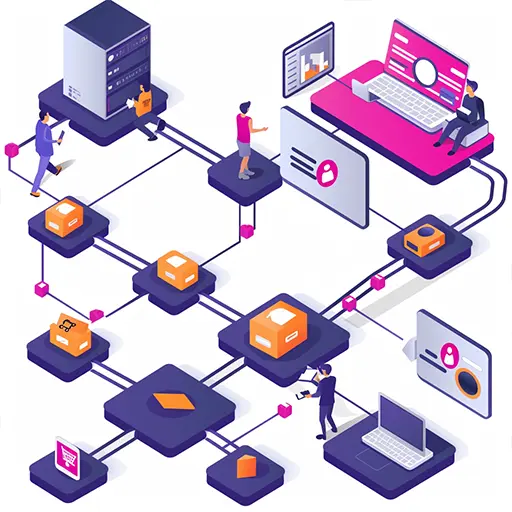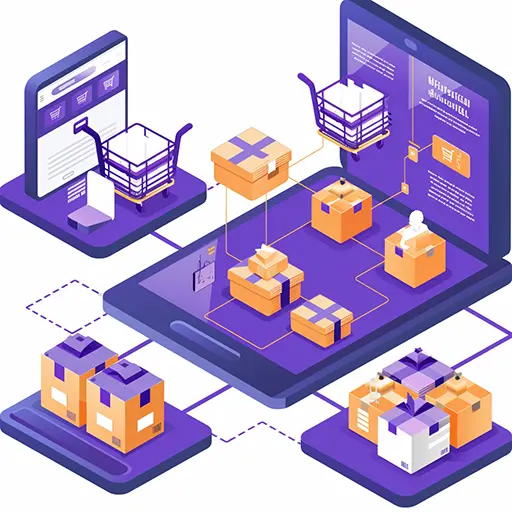
Expand Your Market. Integrating E-commerce into Your Business
Key Points
-
1. Understanding E-commerce Integration
What e-commerce integration involves—connecting online sales systems with traditional business operations.
Subtopics:
- Overview of E-commerce Platforms (Shopify, WooCommerce, Magento)
- Basic Technical Aspects Without Jargon (APIs, plugins)
-
2. Benefits of Integrating E-commerce
How e-commerce can expand market reach and streamline operations.
Subtopics:
- Increased sales through access to a global market.
- Improved customer experience through seamless integration.
-
3. Challenges and Solutions
Common challenges faced by businesses during integration and provide practical solutions.
Subtopics:
- Addressing security concerns with payment gateways.
- Overcoming logistical hurdles in order fulfillment.
Questions: What are your main concerns about moving your business online?
-
4. Step-by-Step Guide to Integration
Guide for integrating e-commerce.
Subtopics:
- Choosing the right platform.
- Setting up an online storefront.
- Integrating existing sales and inventory systems.
-
5. Future Trends in E-commerce
Discuss emerging trends and how they might affect small and medium businesses.
Subtopics:
- The rise of mobile commerce.
- The impact of artificial intelligence on personalized shopping.
Questions: How do you see these trends impacting your business in the next five years?
Introduction
Imagine you're at a bustling community market. Each stall you see is unique, offering something special—perhaps handmade crafts, locally sourced honey, or custom jewelry. Now, imagine you could bring your own stall to this market without the constraints of physical space, reaching customers not just in your town, but across continents. This is the power of integrating e-commerce into your traditional business—it's about expanding your stall's reach to an unimaginable extent, opening up a world of opportunities and potential customers.
For many small to medium business owners, the transition from a physical storefront to an online marketplace can seem daunting. The jargon alone—APIs, plugins, platforms—might feel like a barrier. Yet, the essence of e-commerce integration is simple: it's about connecting your business operations with an online store, enabling you to manage everything from sales to inventory seamlessly.
Understanding E-commerce Integration
E-commerce integration might sound technical, but let's break it down with a simple metaphor. Think of your business as a well-oiled machine—perhaps a vintage car that you've lovingly restored and maintained. Integrating e-commerce is like fitting this car with a modern GPS navigation system. Initially, you might worry it could disrupt the classic feel, or maybe you’re unsure how to install it. However, once in place, it seamlessly provides directions, enhances efficiency, and improves the journey’s comfort, without taking away from the car's vintage charm.
What is E-commerce Integration?
At its core, e-commerce integration involves syncing your traditional business systems—like the cash register, inventory logs, and customer relationship management—with your online store. This sync allows for real-time updates and data sharing, which means less manual entry, fewer errors, and more time focusing on what you love.
Platforms and Tools
You don't need to be a tech guru to embark on this digital journey. There are platforms designed with you, the business owner, in mind:
- Shopify: Imagine a tool that lets you build your online store as easily as stacking blocks. No need to understand the glue holding the blocks together; just focus on how you want it to look and function.
- WooCommerce: For those who already have a website on WordPress, adding WooCommerce is like adding a new room to your house. It blends in with the existing structure, providing a space dedicated to your sales.
- Magento: For businesses planning significant growth, Magento is like a plot of land you purchase, knowing you'll build a mansion on it. It requires more setup but offers extensive customization.
- Custom-Developed Solutions: For those seeking the utmost flexibility and tailored functionality, a custom-developed e-commerce solution might be akin to commissioning a bespoke suit. It's crafted to fit your specific business needs perfectly, without any unnecessary features. This option allows you to innovate beyond the limitations of off-the-shelf platforms, integrating unique features that truly set your online store apart. While this route may require a higher initial investment and ongoing maintenance, the payoff is a solution that fits your business like a glove, potentially offering a significant competitive advantage by optimizing user experience and operational efficiency uniquely suited to your business processes and customer interactions.

Integrating e-commerce doesn’t just open up a new avenue for sales; it connects you to the global market. It's like turning on a beacon that signals to customers from afar that here lies something valuable. As you continue reading, think of how this integration can not only keep your business running smoothly but also expand it beyond traditional boundaries, bringing your unique products to a wider audience than you ever imagined.
Benefits of Integrating E-commerce
Let’s visualize your business not just as a local shop but as a bustling hub, attracting customers from every corner of the globe. This is the transformative power of integrating e-commerce.
Expand Your Reach Globally
Imagine your products reaching a customer in a cozy Parisian apartment or a modern office in Tokyo—places you’ve only dreamed of visiting. E-commerce breaks down geographical barriers. Your online store is like a bridge extending from your local community to the world, inviting international customers to explore your offerings as if they were local.
Streamline Operations
Think of e-commerce integration as hiring an extremely efficient, never-tiring helper. This helper automates processes like stock updates, sales reporting, and customer communications. For instance, when someone buys an item from your online store, the sale is automatically logged, the inventory is updated, and the customer receives a confirmation email. All these happen simultaneously, without you needing to lift a finger. This seamless automation not only reduces errors but also frees up your time, allowing you to focus more on product development and customer service.
Case Study: Local Craft Store Goes Global
Consider a small handcrafted soap shop in Vermont that started selling online last year. Previously, they could only sell to locals and tourists visiting during the summer. After integrating e-commerce, they began receiving orders from all over the U.S. and even Europe, significantly increasing their revenue and allowing them to hire more artisans.

Challenges and Solutions
Every journey has its obstacles, but the right preparation can turn these challenges into stepping stones rather than stumbling blocks.
Addressing Security Concerns
One common worry is the security of online transactions. Think of this as setting up a secure, well-guarded fortress around your customer's data. By choosing platforms that comply with international security standards (like PCI DSS) and using reputable payment gateways, you ensure that customer information is encrypted and secure, akin to locking valuables in a high-tech safe.
Overcoming Logistical Hurdles
Fulfilling orders from various corners of the world can be as complex as orchestrating a symphony—every section must be in perfect harmony. Here, the solution lies in selecting the right logistics partners and employing efficient supply chain management software. These tools are like having a skilled conductor at the helm, ensuring that every package is delivered on time and in pristine condition.
Interactive Element: Reader Poll
Consider this a quick check-in: What aspect of moving online intimidates you the most? Is it the technology, security concerns, or the logistics? Your feedback will help tailor the content to better address your needs.
These points continue to build on the narrative of expanding business horizons through e-commerce, illustrating both the transformative benefits and manageable challenges.
Step-by-Step Guide to Integration
Embarking on the e-commerce journey is like planning a trip to a new destination. You need a map, some essential tools, and a clear set of steps to ensure you reach your destination smoothly.
Choosing the Right Platform
Choosing the right e-commerce platform is akin to selecting the right vehicle for a road trip. Whether you opt for Shopify, WooCommerce, Magento, or a custom solution, each has its strengths and suits different types of journeys. Consider factors like ease of use, scalability, support, and integration capabilities. It’s about finding the perfect fit for your business’s size and where you want to go.
Setting Up an Online Storefront
Setting up your online storefront is like decorating and organizing your store’s physical layout but in the digital world. This step involves designing your website, organizing product categories, and ensuring the user experience is as intuitive as possible. Think of it as arranging your products in the most appealing and accessible way, ensuring customers can easily find what they’re looking for.
Integrating Existing Sales and Inventory Systems
The final step is like ensuring all parts of your vehicle are working in harmony. Integrating your existing sales and inventory systems with your new online platform ensures that your offline and online operations synchronize perfectly. This could involve setting up real-time inventory updates, automated ordering systems, and seamless data sharing across platforms. The goal is to create a cohesive ecosystem that minimizes manual input and maximizes efficiency and customer satisfaction.

Future Trends in E-commerce
Just as it’s vital to stay informed about the weather and road conditions for a trip, understanding future trends in e-commerce can help you navigate the future more effectively.
The Rise of Mobile Commerce
Imagine your business not just on computers but in everyone’s pockets. Mobile commerce is rapidly expanding, much like how smartphones have become a central part of our lives. Optimizing your e-commerce for mobile devices means ensuring your site is as easy and pleasant to use on a phone as it is on a computer.
The Impact of Artificial Intelligence on Personalized Shopping
Artificial Intelligence (AI) in e-commerce is like having a smart assistant who knows your customers individually. AI can analyze shopping habits, personalize recommendations, and even handle customer service interactions, creating a highly personalized shopping experience that attracts repeat business.
Sustainability in E-commerce
As awareness of environmental issues grows, businesses that adopt sustainable practices are increasingly favored by consumers. This trend towards sustainability could mean adopting eco-friendly packaging, optimizing logistics to reduce carbon footprints, or supporting sustainable product sources. It’s about making your e-commerce not just profitable but also responsible.
Interactive Element: Future Trends Poll
Invite readers to vote on which e-commerce trend they find most intriguing or likely to impact their business, helping gauge interest and tailor future content accordingly.
These sections aim to provide practical, step-by-step guidance while also preparing business owners for future developments that could impact their ventures in the e-commerce landscape.
Conclusion: Embracing the Digital Frontier
As we've journeyed through the expansive world of e-commerce integration, we've seen how it's much like charting a course to new horizons. From understanding the basic mechanics of e-commerce platforms to tackling the challenges of security and logistics, and from laying out a step-by-step pathway to success to anticipating future trends, we've covered the essential groundwork needed to expand your business into the digital realm.
The Digital Transformation
Imagine standing on the shore, looking out over the vast ocean. Integrating e-commerce into your business is akin to setting sail on this vast ocean, with endless possibilities on the horizon. It's about reaching farther than the eye can see—touching customers' lives across the globe, optimizing your internal processes, and staying ahead in a rapidly changing market.
The Call to Action
Now is the time to act. Don’t let the fear of the unknown keep you docked at the harbor. Whether you choose a ready-made platform like Shopify or WooCommerce, a robust solution like Magento, or even a custom-developed system tailored specifically to your needs, the important step is to start. Each tool and strategy discussed here serves as a compass to guide you through the complexities of digital commerce.
Engage and Innovate
As you embark on this journey, remember to keep engaging with your customers and innovating your offerings. The digital world is dynamic, and staying responsive to changes and customer needs is key to ongoing success. Use the interactive elements like polls and comments to continue the conversation, gain valuable feedback, and adapt to your audience’s evolving preferences.
Final Thought
E-commerce isn’t just another sales channel—it's a transformational tool that opens up a world of opportunities. By integrating e-commerce, you're not just adapting to the digital age—you're embracing it, ensuring your business thrives and expands in ways you might never have imagined.
Let this be the moment you decide to expand your market and integrate e-commerce into your business strategy. The future is online, and it’s bright with potential. Set sail and seize it!
Explore how integrating e-commerce can expand your business, reach global markets, and streamline operations effectively.
Digital Vantage team
Konrad Barejko, your business partner